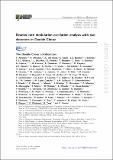| dc.contributor.author | Abrahão, T. | |
| dc.contributor.author | Almazan, H. | |
| dc.contributor.author | dos Anjos, J. C | |
| dc.contributor.author | Appel, S. | |
| dc.contributor.author | Barriere, J. C | |
| dc.contributor.author | Bekman, I. | |
| dc.contributor.author | Bezerra, T. J C | |
| dc.contributor.author | Bezrukov, L. | |
| dc.contributor.author | Blucher, E. | |
| dc.contributor.author | Brugière, T. | |
| dc.contributor.author | Buck, C. | |
| dc.contributor.author | Busenitz, J. | |
| dc.contributor.author | Cabrera, A. | |
| dc.contributor.author | Cerrada, M. | |
| dc.contributor.author | Chauveau, E. | |
| dc.contributor.author | Chimenti, P. | |
| dc.contributor.author | Corpace, O. | |
| dc.contributor.author | Dawson, J. V | |
| dc.date.accessioned | 2021-11-01T14:33:18Z | |
| dc.date.available | 2021-11-01T14:33:18Z | |
| dc.date.issued | 2021-01-28 | |
| dc.identifier.uri | https://hdl.handle.net/1721.1/136777 | |
| dc.description.abstract | Abstract
A θ13 oscillation analysis based on the observed antineutrino rates at the Double Chooz far and near detectors for different reactor power conditions is presented. This approach provides a so far unique simultaneous determination of θ13 and the total background rates without relying on any assumptions on the specific background contributions. The analysis comprises 865 days of data collected in both detectors with at least one reactor in operation. The oscillation results are enhanced by the use of 24.06 days (12.74 days) of reactor-off data in the far (near) detector. The analysis considers the
ν
¯
e
$$ {\overline{\nu}}_e $$
interactions up to a visible energy of 8.5 MeV, using the events at higher energies to build a cosmogenic background model considering fast-neutrons interactions and 9Li decays. The background-model-independent determination of the mixing angle yields sin2(2θ13) = 0.094 ± 0.017, being the best-fit total background rates fully consistent with the cosmogenic background model. A second oscillation analysis is also performed constraining the total background rates to the cosmogenic background estimates. While the central value is not significantly modified due to the consistency between the reactor-off data and the background estimates, the addition of the background model reduces the uncertainty on θ13 to 0.015. Along with the oscillation results, the normalization of the anti-neutrino rate is measured with a precision of 0.86%, reducing the 1.43% uncertainty associated to the expectation. | en_US |
| dc.publisher | Springer Berlin Heidelberg | en_US |
| dc.relation.isversionof | https://doi.org/10.1007/JHEP01(2021)190 | en_US |
| dc.rights | Creative Commons Attribution | en_US |
| dc.rights.uri | https://creativecommons.org/licenses/by/4.0/ | en_US |
| dc.source | Springer Berlin Heidelberg | en_US |
| dc.title | Reactor rate modulation oscillation analysis with two detectors in Double Chooz | en_US |
| dc.type | Article | en_US |
| dc.identifier.citation | Journal of High Energy Physics. 2021 Jan 28;2021(1):190 | en_US |
| dc.contributor.department | Massachusetts Institute of Technology. Department of Physics | |
| dc.identifier.mitlicense | PUBLISHER_CC | |
| dc.eprint.version | Final published version | en_US |
| dc.type.uri | http://purl.org/eprint/type/JournalArticle | en_US |
| eprint.status | http://purl.org/eprint/status/PeerReviewed | en_US |
| dc.date.updated | 2021-05-02T04:11:45Z | |
| dc.language.rfc3066 | en | |
| dc.rights.holder | The Author(s) | |
| dspace.embargo.terms | N | |
| dspace.date.submission | 2021-05-02T04:11:45Z | |
| mit.license | PUBLISHER_CC | |
| mit.metadata.status | Authority Work and Publication Information Needed | |
